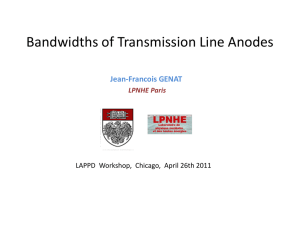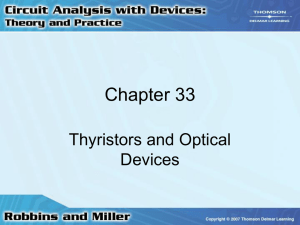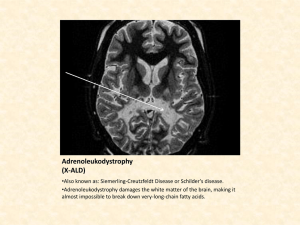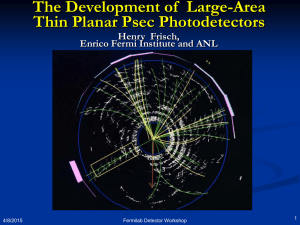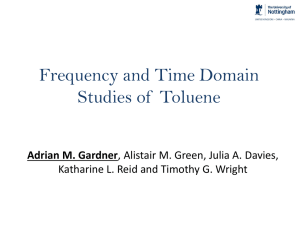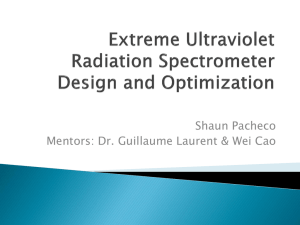Fast Timing: Update on MCP Testing - IIT Center for Accelerator and
advertisement
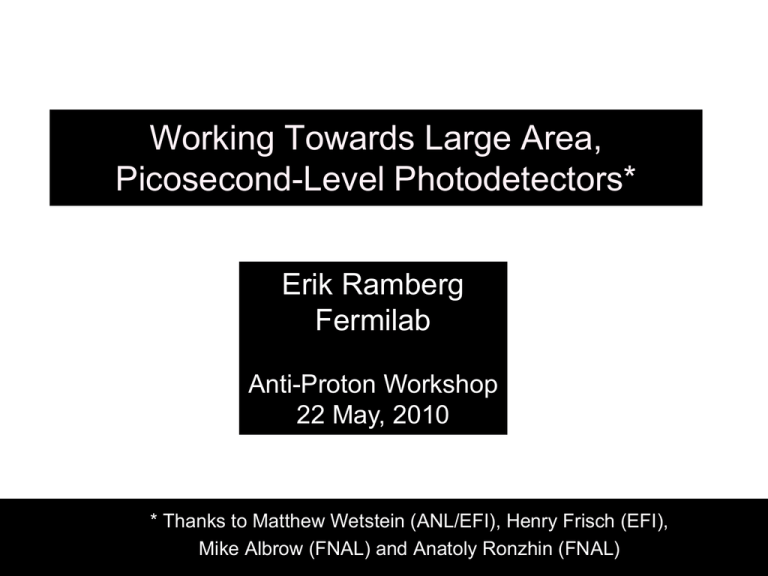
Working Towards Large Area, Picosecond-Level Photodetectors* Erik Ramberg Fermilab Anti-Proton Workshop 22 May, 2010 * Thanks to Matthew Wetstein (ANL/EFI), Henry Frisch (EFI), Mike Albrow (FNAL) and Anatoly Ronzhin (FNAL) LAPPD Collaboration: Large Area Picosecond Photodetectors Time-of-flight (TOF) in Particle Physics • • • Particle identification in High Energy Physics is as important as ever, for investigating flavor physics and rare processes. Traditionally, Cerenkov detectors have outperformed TOF for energies above 2 GeV. Typical TOF resolution (100 picoseconds) has been dominated by physical size of signal generation (cm size of dynode structures) and inherent time scale of scintillation. 100 picoseconds = 3 cm 5 picoseconds = 1.5 mm E. Ramberg/Fast Timing at Fermilab Test Beam/TIPP09 2 LAPPD Collaboration: Large Area Picosecond Photodetectors What If? Large Water-Cherenkov Detectors will likely be a part of future longbaseline neutrino experiments. What if we could build cheap, large-area MCP-PMTs: • ~ 100 psec time resolution. • ~ mm-level spatial resolution. • With close to 100% coverage. • Cost per unit area comparable to conventional PMTs. How could that change the next-gen WC Detectors? • Could these features improve background rejection? • In particular, could more precision in timing information combined with better coverage improve analysis? 3 LAPPD Collaboration: Large Area Picosecond Photodetectors Detector Prescription (Generic) • Small feature size needed (reminder: 300 microns = 1 psec) • Homogeneity the ability to make uniform large-areas (think solarpanels, floor tiles, 50”-HDTV sets) • Intrinsic low cost Although application specific, you need low-cost materials and robust batch fabrication. Needs to be simple. -> Micro-channel plate photo multipliers (MCP/PMT) are our weapon of choice 4/8/2015 LAPPD Collaboration: Large Area Picosecond Photodetectors The LAPPD Collaboration Large Area Picsecond Photodetector Collaboration John Anderson, Karen Byrum, Gary Drake, Henry Frisch, Edward May, Alexander Paramonov, Mayly Sanchez, Robert Stanek, Robert G. Wagner, Hendrik Weerts, Matthew Wetstein, Zikri Zusof High Energy Physics Division, Argonne National Laboratory, Argonne, IL Bernhard Adams, Klaus Attenkofer, Mattieu Chollet Advanced Photon Source Division, Argonne National Laboratory, Argonne, IL Zeke Insepov Mathematics and Computer Sciences Division, Argonne National Laboratory, Argonne, IL Mane Anil, Jeffrey Elam, Joseph Libera, Qing Peng Energy Systems Division, Argonne National Laboratory, Argonne, IL Michael Pellin, Thomas Prolier, Igor Veryovkin, Hau Wang, Alexander Zinovev Materials Science Division, Argonne National Laboratory, Argonne, IL Dean Walters • • • • • Funded by DOE and NSF 4 National Labs 5 Divisions at Argonne 3 US small companies; Electronics expertise at Universities of Chicago and Hawaii Nuclear Engineering Division, Argonne National Laboratory, Argonne, IL David Beaulieu, Neal Sullivan, Ken Stenton Arradiance Inc., Sudbury, MA Sam Asare, Michael Baumer, Mircea Bogdan, Henry Frisch, Jean-Francois Genat, Herve Grabas, Mary Heintz, Sam Meehan, Richard Northrop, Eric Oberla, Fukun Tang, Matthew Wetstein, Dai Zhongtian Enrico Fermi Institute, University of Chicago, Chicago, IL Erik Ramberg, Anatoly Ronzhin, Greg Sellberg Fermi National Accelerator Laboratory, Batavia, IL James Kennedy, Kurtis Nishimura, Marc Rosen, Larry Ruckman, Gary Varner University of Hawaii, Honolulu, HI Robert Abrams, valentin Ivanov, Thomas Roberts Muons, Inc., Batavia, IL Jerry Va’vra SLAC National Accelerator Laboratory, Menlo Park, CA Oswald Siegmund, Anton Tremsin Space Sciences Laboratory, University of California, Berkeley, CA Dimitri Routkevitch Goals: • Exploit advances in material science and nanotechnology to develop new, batch methods for producing cheap, large area MCPs. • To develop a commercializable product on a three year time scale. Synkera Technologies Inc., Longmont, CO David Forbush, Tianchi Zhao Department of Physics, University of Washington, Seattle, WA 5 LAPPD Collaboration: Large Area Picosecond Photodetectors Detector Development- 3 Prongs MCP development: use modern fabrication processes to control emissivities, resistivities, out-gassing Use Atomic Layer Deposition for emissive material. Amplification on cheap inert substrates (glass capillary arrays, AAO). Scalable to large sizes, economical, chemically robust and stable. Readout: use transmission lines and modern chip technologies for high speed cheap low-power high-density readout. Anode is a 50-ohm stripline, scalable up to many feet in length. Readout 2 ends; CMOS sampling onto capacitors- fast, cheap, lowpower Simulation: use computational advances to make design choices. Modern computing tools allow simulation at level of basic processesvalidate with data. 4/8/2015 Application 1-Energy Frontier At colliders we measure the 3-momenta of hadrons, but can’t follow the flavor-flow of quarks, the primary objects that are colliding. 2-orders-of-magnitude in time resolution would allow us to measure ALL the information=>greatly enhanced discovery potential. Specs: Signal: 50-10,000 photons Space resolution: 1 mm Time resolution 1 psec Cost: <100K$/m2: t-tbar -> W+bW-bbar at CDF 7 Application 2- Lepton Flavor Physics LAPPD Collaboration: Large Area Picosecond Photodetectors Application 2 - Intensity Frontier • Example- DUSEL detector with 100% coverage and 3D photon vertex reconstruction. • Need >10,000 square meters! • Spec: single photon sensitivity, 100 ps time, 1 cm space, low cost (5-10K$/m2) 8 LAPPD Collaboration: Large Area Picosecond Photodetectors Application 3- Medical Imaging (PET) Depth of interaction measurement currently has best value of 375 ps (1 cm) resolution (H. Kim, UC). Spec: signal 10,000 photons,30 ps time, 1 mm space, 30K$/m2, MD-proof 9 LAPPD Collaboration: Large Area Picosecond Photodetectors PET (UC/BSD, UCB, Lyon) Parallel. Efforts on Specific Applications Collider (UC, ANL,SLAC,. . LAPPD Detector Development ANL,Arradiance,Chicago,Fermil ab, Hawaii,Muons,Inc,SLAC,SSL/U CB, Synkera, U. Wash. DUSEL K->pnn (Matt, Mayly, Bob, John, ..) Drawing Not To Scale (!) (UC(?)) Security (TBD) 10 LAPPD Collaboration: Large Area Picosecond Photodetectors Anatomy of an MCP-PMT 1. 2. 3. 4. 5. Photocathode Multichannel Plates Anode (stripline) structure Vacuum Assembly Front-End Electronics Conversion of photons to electrons. 11 LAPPD Collaboration: Large Area Picosecond Photodetectors Anatomy of an MCP-PMT 1. 2. 3. 4. 5. Photocathode Microchannel Plates Anode (stripline) structure Vacuum Assembly Front-End Electronics Amplification of signal. Consists of two plates with tiny pores (~10 microns), held at high potential difference. Initial electron collides with pore-walls producing an avalanche of secondary electrons. Key to our effort. 12 LAPPD Collaboration: Large Area Picosecond Photodetectors Anatomy of an MCP-PMT 1. 2. 3. 4. 5. Photocathode Microchannel Plates Anode (stripline) structure Vacuum Assembly Front-End Electronics Charge collection. Brings signal out of vacuum. 13 LAPPD Collaboration: Large Area Picosecond Photodetectors Anatomy of an MCP-PMT 1. 2. 3. 4. 5. Photocathode Microchannel Plates Anode (stripline) structure Vacuum Assembly Front-End Electronics Maintenance of vacuum. Provides mechanical structure and stability to the complete device. 14 LAPPD Collaboration: Large Area Picosecond Photodetectors Anatomy of an MCP-PMT 1. 2. 3. 4. 5. Photocathode Microchannel Plates Anode (stripline) structure Vacuum Assembly Front-end electronics Acquisition and digitization of the signal. 15 LAPPD Collaboration: Large Area Picosecond Photodetectors Channel Plate Fabrication Conventional MCP Fabrication • Pore structure formed by drawing and slicing lead-glass fiber bundles. The glass also serves as the resistive material • Chemical etching and heating in hydrogen to improve secondary emissive properties. • Expensive, requires long conditioning, and uses the same material for resistive and secondary emissive properties. (Problems with thermal run-away). Proposed Approach • Separate out the three functions • Hand-pick materials to optimize performance. • Use Atomic Layer Deposition (ALD): a cheap industrial batch method. 16 LAPPD Collaboration: Large Area Picosecond Photodetectors Front-end Electronics/Readout Waveform sampling ASIC Electronics Group: Jean-Francois Genat, Gary Varner, Mircea Bogdan, Michael Baumer, Michael Cooney, Zhongtian Dai, Herve Grabas, Mary Heintz, James Kennedy, Sam Meehan, Kurtis Nishimura, Eric Oberla, Larry Ruckman, Fukun Tang (meets weekly) Have to understand signal and noise in the frequency domain 17 LAPPD Collaboration: Large Area Picosecond Photodetectors Front End Electronics • Collaboration between U of Chicago and Hawaii. • Resolution depends on # photoelectrons, analog bandwidth, and signal-to-noise. • Transmission Line: readout both ends position and time • Cover large areas with much reduced channel count. • Simulations indicate that these transmission lines could be scalable to large detectors without severe degradation of resolution. Wave-form sampling is best, and can Differential time resolution between be implemented in low-power widely two ends of a strip line available CMOS processes (e.g. IBM 8RF). Low cost per channel. First chip submitted to MOSIS -- IBM 8RF (0.13 micron CMOS)- 4-channel prototype. Next chip will have self-triggering and phase-lock loop J-F. Genat, G. Varner, M. Bogdan, M. Baumer, M. Cooney, Z. Dai, H. Grabas, M. Heintz, J. Kennedy, S. Meehan, K. Nishimura, E. Oberla, L.Ruckman, F. Tang 18 Collaboration: Large Area Picosecond Photodetectors Photonis LAPPD Planicon on Transmission Line Board Couple 1024 pads to strip-lines with silver-loaded epoxy (Greg Sellberg, Fermilab). 19 LAPPD Collaboration: Large Area Picosecond Photodetectors Simulation • Working to develop a firstprinciples model to predict MCP behavior, at device-level, based on microscopic parameters. Transit Time Spread (TTS) • Will use these models to understand and optimize our MCP designs. Z. Yusov, S. Antipov, Z. Insepov (ANL), V. Ivanov (Muons,Inc), A. Tremsin (SSL/Arradiance), N. Sullivan (Arradiance) 20 LAPPD Collaboration: Large Area Picosecond Photodetectors Scaling Performance to Large Area Anode Simulation(Fukun Tang) • 48-inch Transmission Line- simulation shows 1.1 GHz bandwidth- still better than present electronics. KEY POINT- READOUT FOR A 4-FOOT-WIDE DETECTOR IS THE SAME AS FOR A LITTLE ONEHAS POTENTIAL… 21 LAPPD Collaboration: Large Area Picosecond Photodetectors Mechanical Assembly Rich Northrop, Dean Walters, Joe Gregar Bob Wagner, Michael Minot, Jason McPhate, Ossy Siegmund 8” proto-type stack design sketch 8” proto-type mock-up BNL Colloquium 4/8/2015 22 LAPPD Collaboration: Large Area Picosecond Photodetectors The 24”x16” `SuperModule Tile now has no penetrations- neither HV nor signals Digital card in design Front-end ASICs ditto Mockup of 1x3 ½ SM Real glass parts Electrical tests in air in situ about to begin BNL Colloquium 4/8/2015 23 LAPPD Collaboration: Large Area Picosecond Photodetectors Channel Plate Fabrication w/ ALD pore 1. Start with a porous, insulating substrate that has appropriate channel structure. 1 KV Alternative ALD Coatings: borosilicate glass filters (default) Anodic Aluminum Oxide (AAO) 2. Apply a resistive coating (ALD) 3. Apply an emissive coating (ALD) 4. Apply a conductive coating to the top and bottom (thermal evaporation or sputtering) Al2O3 Conventional MCP’s: SiO2 (ALD SiO2 also) MgO ZnO 24 LAPPD Collaboration: Large Area Picosecond Photodetectors Status After Several Months • Using our electronic front-end and striplines with a commercial Photonis MCP-PMT, were able to achieve 1.95 psec differential resolution, 97 µm position resolution (158 photoelectrons). • Demonstrated ability produce 33 mm ALD coated channel-plate samples. • Development of advanced testing capabilities underway. • Preliminary results at APS show amplification in a commercial MCP after ALD coating. • Growing collaboration between simulation and testing groups. B. Adams, M. Chollet (ANL/APS), M. Wetstein (UC, ANL/HEP) • After characterizing the Photonis MCP, we coat the plates with 10 nm Al2O3. • The “after-ALD” measurements have been taken without scrubbing. • These measurements are ongoing. 25 Beam line time-of-flight for particle identification LAPPD Collaboration: Large Area Picosecond Photodetectors Testing the Photek 240 MCP/PMT in Fermilab’s Test Beam at + 7m far position B 8 GeV/c p or π VETO L+R C = PMT210 reference B A TRIG L*R SiPM’s also an option and were tested. 26 Some Results: LAPPD Collaboration: Large Area Picosecond Photodetectors Test Beam Results for 120 GeV monoenergetic protons beam on quartz bar detector Remove tails of PH distributions (correlated, probably interactions) Apply time-slewing correction (CFD needs residual PH correction) Fit Dt = (t1 – t2) to Gaussian: channels sDt = 16 ps, which means each device contributes 11 ps 27 Positive 8 GeV/c beam over 7 m: LAPPD Collaboration: Large Area Picosecond Photodetectors Test Beam Results for 7 meter separation in 8 GeV mixed (muons, pions, protons, electrons) beam π p Proton content of beam gives 146 ps difference Resolution of timing difference σ = 7 ch = 21.7 ps 28 (No corrections for slewing etc) LAPPD Collaboration: Large Area Picosecond Photodetectors Conclusions • The large area, fast timing photodetector project is an advanced cooperative research project, headed up by U. Chicago, and highly supported by the DOE. We’re on a 3 year time table. Lots of work ahead. Preliminary achievements are encouraging. • The cooperation between quite different research areas (materials science, space science, high energy physics, medical imaging) is striking and is perhaps a model for future endeavors. • If successful, this project presents potential opportunities for future water Cherenkov detectors, collider detectors, fixed target detectors, medical imaging, etc. 29
